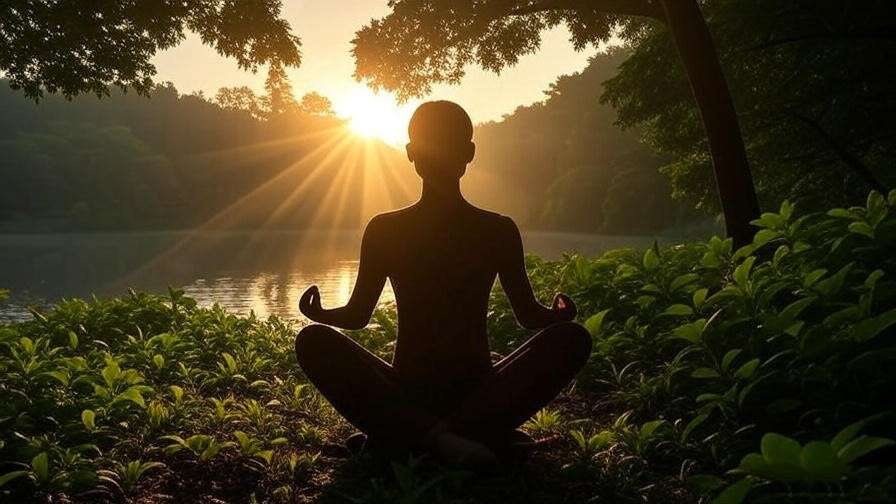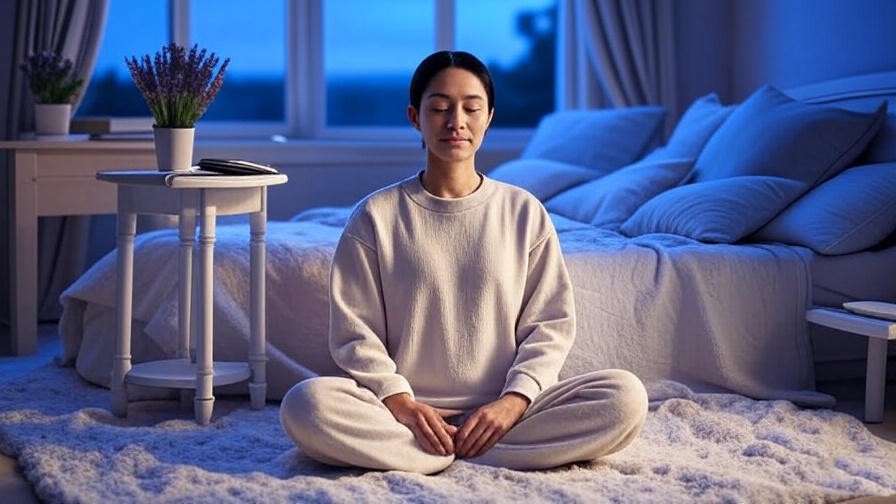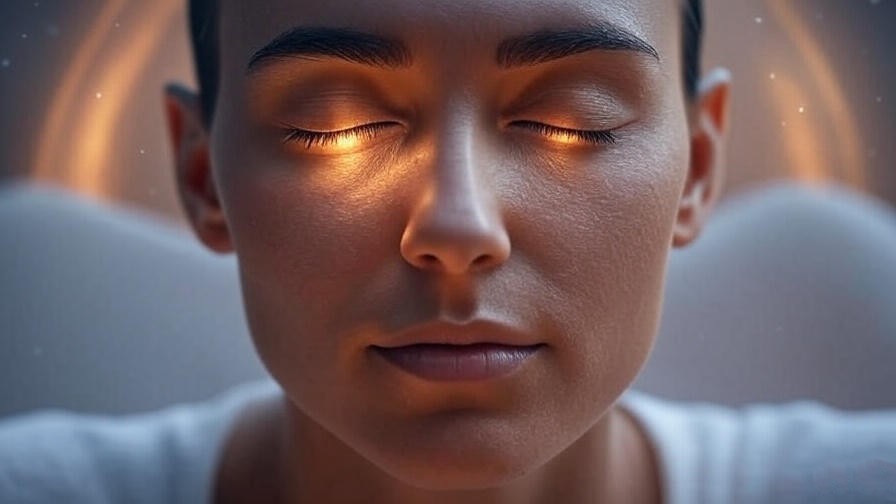Picture this: It’s late at night, your mind is racing with endless to-do lists, and sleep feels like a distant dream. The weight of modern life—stress, anxiety, and constant distractions—leaves you yearning for peace. What if a simple, accessible practice could transform your mental clarity, improve your sleep, and bring lasting happiness? Enter Shri Mataji Nirmala Devi Self Realization Meditation, a cornerstone of Sahaja Yoga that awakens your inner energy to foster holistic well-being. Founded by Shri Mataji Nirmala Devi, this meditation practice offers a path to inner peace, emotional balance, and spiritual growth. In this comprehensive guide, we’ll explore how this transformative practice can help you achieve better sleep, reduce stress, and live a happier, healthier life. From step-by-step instructions to scientific insights, you’ll discover why this meditation is a game-changer for your well-being.
Who Was Shri Mataji Nirmala Devi?

A Visionary Spiritual Leader
Shri Mataji Nirmala Devi (1923–2011) was a globally revered spiritual teacher who dedicated her life to making self-realization accessible to all. Born in India, she founded Sahaja Yoga in 1970, a meditation practice rooted in the belief that everyone can awaken their inner spiritual energy, known as Kundalini, to achieve balance and peace. Unlike many spiritual movements, Shri Mataji emphasized that true self-realization requires no payment or exclusivity—her teachings were freely shared worldwide. Her legacy spans over 100 countries, with millions of practitioners embracing her vision of universal spirituality.
As Dr. Ramesh Manocha, a Sahaja Yoga practitioner and researcher, notes, “Shri Mataji’s approach demystified meditation, making it a practical tool for mental and physical health.” Her work continues to inspire those seeking holistic well-being, from improved sleep to emotional resilience.
The Origins of Sahaja Yoga
Sahaja Yoga, meaning “spontaneous union” in Sanskrit, was born from Shri Mataji’s realization that self-realization could be a universal experience. In 1970, she developed a simple method to awaken the Kundalini energy within individuals, leading to a state of thoughtless awareness and inner peace. Unlike complex spiritual practices, Sahaja Yoga requires no prior knowledge or rigorous training. Shri Mataji’s teachings focus on the subtle energy system—comprising chakras and energy channels—that governs our physical, mental, and emotional health. By activating this system through Shri Mataji Nirmala Devi Self Realization Meditation, practitioners can achieve balance and clarity effortlessly.
What Is Self Realization Meditation?
Understanding Self Realization
Self-realization, in the context of Sahaja Yoga, is the process of connecting with your true self by awakening the Kundalini energy. Unlike mindfulness, which focuses on present-moment awareness, or transcendental meditation, which uses mantras, Shri Mataji Nirmala Devi Self Realization Meditation emphasizes a spontaneous, natural connection to your inner energy. This practice leads to a state of thoughtless awareness, where the mind is calm yet alert, free from the clutter of stress and overthinking. It’s a deeply personal yet universal experience that aligns body, mind, and spirit.
The Role of Kundalini Energy
At the core of Sahaja Yoga is the concept of Kundalini, a dormant spiritual energy located at the base of the spine. Shri Mataji taught that this energy, when awakened, rises through the body’s energy centers (chakras), clearing blockages and restoring balance. Think of Kundalini as a seed within you, waiting to blossom into a state of peace and self-awareness. By practicing Shri Mataji Nirmala Devi Self Realization Meditation, you activate this energy, which nurtures your mental, emotional, and physical well-being. This process is gentle, natural, and accessible to everyone, regardless of age or background.
Why It’s Accessible to Everyone
One of the most remarkable aspects of Sahaja Yoga is its inclusivity. Shri Mataji designed the practice to be simple and free, requiring no special skills or costly courses. Whether you’re a busy professional, a parent, or someone new to meditation, you can begin your journey to self-realization today. The practice involves sitting comfortably, following guided steps, and allowing your Kundalini to rise naturally. This accessibility makes it a powerful tool for those seeking better sleep, stress relief, or spiritual growth without the barriers of traditional meditation practices.
The Science Behind Shri Mataji Nirmala Devi Self Realization Meditation
How Meditation Impacts the Brain
Scientific research supports the transformative power of meditation, including Sahaja Yoga. Studies published in journals like Frontiers in Psychology show that meditation reduces cortisol levels, the stress hormone, while enhancing neuroplasticity—the brain’s ability to adapt and form new connections. Shri Mataji Nirmala Devi Self Realization Meditation promotes a state of thoughtless awareness, which studies suggest can decrease activity in the brain’s default mode network, linked to overthinking and anxiety. This leads to improved focus, emotional regulation, and mental clarity—key components of holistic well-being.
Physical and Emotional Benefits
The benefits of Sahaja Yoga extend beyond the mind. Research from the Journal of Clinical Psychology indicates that meditation practices like Sahaja Yoga can lower blood pressure, improve immune function, and reduce symptoms of anxiety and depression. Practitioners often report better sleep quality, a critical factor for those exploring the website’s focus on sleep and wellness. For example, Sarah, a 35-year-old teacher, shared, “After practicing Sahaja Yoga for a month, I noticed I was falling asleep faster and waking up refreshed. My stress levels dropped significantly.” These outcomes align with Shri Mataji’s teachings on balancing the body’s energy for overall health.
The Mind-Body Connection
Sahaja Yoga works by harmonizing the parasympathetic nervous system, which promotes relaxation and recovery. When Kundalini energy rises, it balances the body’s chakras, addressing physical and emotional imbalances. For instance, the heart chakra, associated with love and compassion, can influence emotional well-being, while the root chakra supports feelings of security and grounding. By fostering this mind-body connection, Shri Mataji Nirmala Devi Self Realization Meditation helps you achieve a state of calm that enhances sleep, reduces stress, and promotes happiness.
How to Practice Shri Mataji Nirmala Devi Self Realization Meditation

Step-by-Step Guide to Self Realization
Ready to begin? Here’s a beginner-friendly guide to practicing Shri Mataji Nirmala Devi Self Realization Meditation:
- Find a Quiet Space: Choose a comfortable, distraction-free environment. Sit on a chair or the floor with your spine straight.
- Open Your Hands: Place your hands palm-up on your lap to receive energy.
- Follow Guided Steps: Use a free Sahaja Yoga guided meditation (available on the official Sahaja Yoga website) to awaken your Kundalini. Shri Mataji’s recorded sessions often include affirmations like, “I am my own master.”
- Visualize Kundalini Rising: Focus on the sensation of energy moving upward through your spine, clearing your chakras.
- Enter Thoughtless Awareness: Allow thoughts to fade, embracing a calm, alert state.
Practice for 10–15 minutes daily, ideally in the morning or before bed to enhance sleep quality.
Tips for Beginners
- Start Small: Begin with short sessions and gradually increase duration as you feel comfortable.
- Use Resources: Explore free guided meditations on the official Sahaja Yoga website or YouTube channel.
- Be Patient: It’s normal for thoughts to wander. Gently refocus on your breath or affirmations.
- Practice Before Bed: Meditating at night can calm your mind, making it easier to fall asleep—a perfect fit for the website’s sleep focus.
- Join a Class: Many cities offer free Sahaja Yoga classes for hands-on guidance.
Creating a Meditation Routine
To maximize benefits, integrate Shri Mataji Nirmala Devi Self Realization Meditation into your daily routine. Here’s a sample weekly schedule:
- Morning (10 minutes): Start your day with meditation to boost focus and energy.
- Evening (15 minutes): Unwind before bed to promote restful sleep.
- Weekend (20 minutes): Dedicate longer sessions to deepen your practice.
Keep a journal to track changes in your mood, sleep quality, or stress levels. Over time, you’ll notice subtle shifts in your well-being, from improved relaxation to greater emotional resilience.
Benefits of Shri Mataji Nirmala Devi Self Realization Meditation for Holistic Well-Being

Mental Clarity and Emotional Balance
Shri Mataji Nirmala Devi Self Realization Meditation fosters a state of thoughtless awareness that clears mental clutter and promotes emotional stability. By quieting the mind, this practice reduces anxiety and helps you respond to challenges with calm and clarity. Practitioners often describe a sense of lightness, as if a weight has been lifted from their minds. For instance, John, a 42-year-old software engineer, shared, “After practicing Sahaja Yoga for two months, I felt less overwhelmed by work stress. I could focus better and felt more in control of my emotions.” This mental clarity is a cornerstone of holistic well-being, aligning with the website’s focus on happiness and mental health.
Improved Sleep and Relaxation
One of the most sought-after benefits of Shri Mataji Nirmala Devi Self Realization Meditation is its ability to improve sleep quality—a key concern for readers of this website. By activating the parasympathetic nervous system, this practice reduces stress hormones that keep you awake at night. Shri Mataji emphasized that balancing the body’s energy channels promotes deep relaxation, making it easier to fall asleep and stay asleep. Research supports this: a 2015 study in Sleep Medicine Reviews found that meditation practices enhance sleep by reducing hyperarousal. Practicing before bed can be particularly effective, helping you unwind and prepare for restful slumber.
Spiritual Growth and Happiness
Beyond physical and mental benefits, Sahaja Yoga nurtures spiritual growth by connecting you to your inner self and the universe. Shri Mataji taught that self-realization awakens a sense of joy that transcends external circumstances. This aligns with the website’s theme of happiness, as practitioners often report feeling more content and fulfilled. The practice encourages self-awareness and compassion, fostering a deeper sense of purpose. As one practitioner noted, “Sahaja Yoga helped me find joy within myself, not just in achievements or material things.” This spiritual fulfillment enhances overall well-being, making life feel more meaningful.
Long-Term Health Benefits
Regular practice of Shri Mataji Nirmala Devi Self Realization Meditation can contribute to long-term health improvements. Studies, such as those published in The American Journal of Cardiology, suggest that meditation lowers blood pressure, reduces inflammation, and strengthens immune function. By balancing the body’s energy system, Sahaja Yoga addresses chronic stress, a known contributor to conditions like heart disease and insomnia. These benefits make it a powerful tool for readers seeking holistic health solutions, complementing lifestyle changes like healthy eating and exercise.
Common Myths and Misconceptions About Self Realization Meditation
“It’s Only for Spiritual People”
A common misconception is that Shri Mataji Nirmala Devi Self Realization Meditation is exclusively for those with a spiritual inclination. In reality, Sahaja Yoga is designed for everyone, regardless of beliefs or background. Shri Mataji emphasized its universal applicability, noting that self-realization benefits mental and physical health, not just spiritual growth. Whether you’re seeking stress relief, better sleep, or emotional balance, this practice offers tangible results without requiring a spiritual commitment.
“It’s Complicated or Time-Consuming”
Some assume that meditation, especially one involving Kundalini, is complex or time-intensive. However, Sahaja Yoga is remarkably simple. A typical session lasts 10–15 minutes and requires no special equipment or training. Shri Mataji’s method involves straightforward affirmations and guided steps, making it ideal for busy individuals. You can practice at home, during a lunch break, or before bed, seamlessly integrating it into your routine.
“It Requires Special Skills or Training”
Another myth is that self-realization meditation demands advanced skills or years of practice. Shri Mataji designed Sahaja Yoga to be beginner-friendly, with no prerequisites. The process of awakening Kundalini is natural and spontaneous, guided by your own inner energy. Free resources, such as online guided meditations and local Sahaja Yoga classes, provide all the support you need to start immediately.
How Shri Mataji Nirmala Devi Self Realization Meditation Fits Into Your Life

Complementing Other Wellness Practices
Shri Mataji Nirmala Devi Self Realization Meditation pairs beautifully with other wellness practices, enhancing their effectiveness. For example, combining it with gentle yoga can deepen physical relaxation, while mindfulness practices can amplify mental clarity. For readers focused on sleep, meditating before bed complements habits like avoiding screens or maintaining a consistent sleep schedule. A holistic routine might include morning meditation for energy, evening meditation for relaxation, and healthy habits like mindful eating to support overall well-being.
Finding Community and Support
Sahaja Yoga is more than a solo practice—it’s a global community. Free Sahaja Yoga centers, available in cities worldwide, offer group meditations and workshops. These sessions provide hands-on guidance and a sense of connection, which can enhance motivation and deepen your practice. Online platforms, like the official Sahaja Yoga website, offer free guided meditations, videos, and forums to connect with practitioners. Joining a community can make the journey more rewarding, especially for beginners seeking support.
Real-Life Success Stories
To illustrate the impact of Shri Mataji Nirmala Devi Self Realization Meditation, consider these real-life examples:
- Emma, 29, Marketing Manager: Struggling with anxiety and poor sleep, Emma discovered Sahaja Yoga through a friend. After practicing for three weeks, she noticed calmer evenings and deeper sleep. “I feel more grounded, and my mind doesn’t race at night anymore,” she says.
- Raj, 45, Small Business Owner: Raj turned to Sahaja Yoga to manage work stress. Within a month, he felt more focused and less reactive to challenges. “It’s like I found a reset button for my mind,” he shares.
- Lisa, 60, Retiree: Seeking purpose in retirement, Lisa joined a local Sahaja Yoga group. The practice brought her a sense of inner joy and improved her energy levels. “I feel connected to something bigger,” she reflects.
These stories highlight how Sahaja Yoga addresses the website’s themes of sleep, happiness, and holistic well-being.
Frequently Asked Questions (FAQs)
What is the difference between Shri Mataji Nirmala Devi Self Realization Meditation and other meditation practices?
Unlike mindfulness, which focuses on observing thoughts, or transcendental meditation, which uses mantras, Sahaja Yoga centers on awakening Kundalini energy for spontaneous self-realization. This leads to thoughtless awareness, a state of calm alertness unique to Shri Mataji’s method.
How long does it take to experience benefits?
Some practitioners feel immediate relaxation, such as a sense of calm or lighter thoughts, after their first session. Deeper benefits, like improved sleep or reduced stress, often emerge within 2–4 weeks of daily practice for 10–15 minutes.
Can I practice this meditation if I’m not spiritual?
Absolutely. Sahaja Yoga is designed for everyone, offering practical benefits like stress relief, better sleep, and emotional balance, regardless of spiritual beliefs. Shri Mataji emphasized its universal accessibility.
Are there any costs involved?
No. Shri Mataji insisted that Sahaja Yoga remain free, true to her vision of universal self-realization. Free classes, online resources, and guided meditations are widely available.
How does this meditation improve sleep?
By calming the nervous system and reducing stress, Shri Mataji Nirmala Devi Self Realization Meditation promotes relaxation, making it easier to fall asleep and stay asleep. Practicing before bed can enhance sleep quality significantly.
Conclusion
Shri Mataji Nirmala Devi Self Realization Meditation offers a powerful, accessible path to inner peace, better sleep, and holistic well-being. Rooted in Shri Mataji’s vision of universal self-realization, this practice awakens your Kundalini energy, fostering mental clarity, emotional balance, and spiritual growth. Whether you’re battling stress, seeking restful sleep, or yearning for deeper happiness, Sahaja Yoga provides a practical solution that fits seamlessly into your life. Start today with the step-by-step guide, explore free resources on the official Sahaja Yoga website, or join a local class to experience the benefits firsthand. Share this article with others seeking peace, and take the first step toward a happier, healthier you.


















